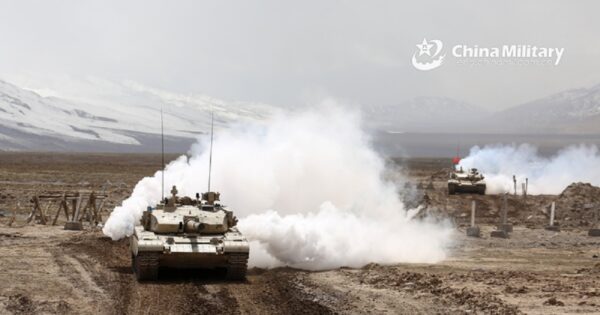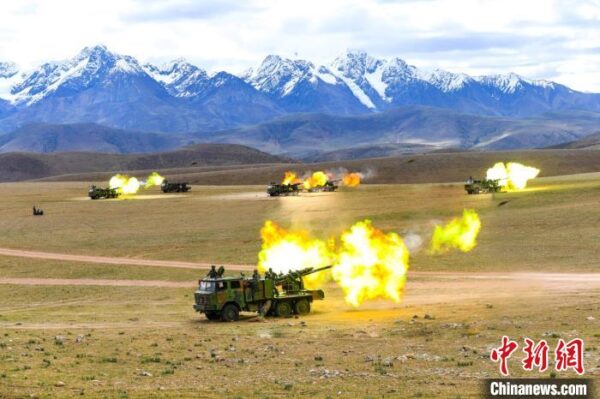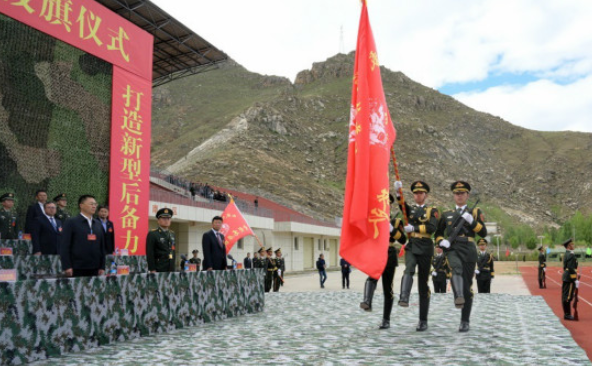As tensions between India and China flare up, the International Campaign for Tibet has noted China’s increased military drills in Tibet, which are leading to the further militarization of a country that once served as a peaceful buffer between India and China.
In a projection of military power, China’s People’s Liberation Army conducted several military drills in Tibet in the past four weeks. These drills were reported to be “comprehensive exercises” in a high-altitude area to “comprehensively test the joint combat capability of the troops in the plateau environment” and included exercises wherein “attack forces marched into enemy depths as drones were set to fly for reconnaissance and obstacle sabotage,” according to state media. Despite taking place during a period of tension with India, Chinese military authorities announced that the “exercises are routine arrangements within the annual training plan and do not target any specific country.”

Chinese military released this photo of type-99 main battle tanks (MBTs) of the PLA 76th Group Army in action at a military drill in Tibet on June 4
Dangerous drills
Chinese state media Xinhua reported on June 3, 2020 that the PLA Tibet Military Command had “conducted a post-enemy penetration and attack drill.” The location was not disclosed but the report quoted Ma Gan, head of a reconnaissance battalion, as saying that in this exercise, officers and soldiers used anti-tank rockets, mortars, and grenade launchers to fire live ammunition under the full tactical background. In another state media report on June 16, during a night drill, the PLA’s 76th brigade, under the Western Theatre Command, fired “more than 2,000 munitions, including mortar shells, rifle grenades and rockets” at an elevation of 4,700 meters in the foothills of Nyenchen Thangla (Chinese: Nianqing Tangulla) Mountains, located to the north of the Tibetan capital Lhasa. Similarly, in a report on June 24, Xinhua said China’s Ministry of National Defense announced that the Tibet Military Region had “recently held comprehensive exercises in high-altitude regions.”
Such extensive military drills appear not only to be messages to India, but also have the dangerous potential to destabilize Tibet and to create a climate of fear among Tibetans under Chinese rule. Tibet, a historically independent country, occupies a strategic place in Asia. Indian geopolitical analyst Brahma Chellaney explained in an article in 2019, “Today, Tibet remains at the centre of the India-China divide, fuelling territorial disputes, diplomatic tensions and riparian feuds. Indeed, the fall of Tibet represented the most far-reaching geopolitical development in modern India’s history. It gave China borders with India, Bhutan and Nepal for the first time, and opened the path to a Sino-Pakistan strategic axis. The impact has been exacerbated by serial Indian blunders.”
Chellaney added, “China’s increasing militarization of Tibet directly impinges on Indian security.”

Artillery trucks in action in one of the military drills in Tibet.
Creation of militias
The Chinese government has also established local militias in Tibet to integrate military personnel and civilians for China’s ongoing tensions with India.
Five militia groups code-named after animals and prefixed by “snow” were announced on June 15 as part of the implementation of the Chinese government’s policy to “govern the borders by first stabilizing Tibet.” The militias — Snow Eagle Air Patrol, Snow Dove Polar Communication Team, Snow Wolf Extreme Climbing Team, Snow Fox Alpine Express Team, and Snow Mastiff Plateau Resistance Team — are to take part in patrolling, communication and fighting.
Chinese media said a formal ceremony took place on June 15 attended by officials where the PLA officially launched the five militia groups. Tibet Military Region Commander Wang Haijiang awarded the flags to the groups and is reported as telling them that Tibet’s natural environment and traffic conditions are complex, and ordinary forces are unable to reach all areas when carrying out emergency response tasks. He reportedly told them that their inclusion greatly enhanced the organization and mobilization of Tibet’s reserve forces, according to the state media.
Since the Chinese Communist Party’s 19th National Congress in 2017, the Tibet Military Region has built strong militia teams of civilians for combat effectiveness, media outlet Sina News reported, citing an article published in “China National Defense News” on June 15.

Ceremony on June 15 during which the five militia groups were launched by the Tibet Military Region
Insensitivity to Tibet’s environment
The drills, conducted on the Tibetan Plateau, are also potentially harmful to Tibet’s environment and culture. Known as the roof of the world, the plateau, which averages 4,500 meters in elevation, has a harsh and fragile environment.
But instead of recognizing the environmental sensitivity of the plateau, the PLA views it as an obstacle to conquer. A common theme in state media boasts of the PLA triumphantly conquering the “harsh environment” of Tibet to overcome natural obstacles for military operations.
In one propaganda video clip, a young soldier positioned in a battle tank declares that “the harsh environment brought us a lot of difficulties, but also tempered our ability to perform tasks under complex environmental conditions.”
The same propaganda clip displays a trainload of battle tanks being transported on the Lanzhou-Urumqi railway that passes through the Tibetan region of northern Amdo in Qinghai Province.
Assault on Tibetan culture and beliefs
For millennia, mountains have played a unique role in Tibetan culture. The Tibetan belief system—beginning with the pre-Buddhist Bon culture that dates back thousands of years—views mountains as sacred.
Thus, Tibetans limited human activity on or near the mountains. Instead of conquering them, Tibetans tended to the mountains as their stewards for millennia.
In contrast, the PLA’s use of heavy modern artillery during its drills at the Nyenchen Thangla mountains and at “the hinterland of the Kunlun mountains”—possibly in Tsonub (Haixi) Mongol & Tibetan Autonomous Prefecture in Qinghai Province—is an assault on Tibetan environment and culture of Tibet.
Influx of soldiers
Earlier this month, Voice of America reported on the arrival of PLA reinforcement troops in Lhasa, the capital city of Tibet.
Citing an anonymous source, VOA reported that since June 5, large groups of PLA soldiers have been arriving at Lhasa’s railway station. All the arriving soldiers report to a new military base that opened in 2019 and sits about 12 kilometers from the sacred Jokhang Temple.
The troops then deploy to the cities of Lhoka (Shannan) and Shigatse (Rikaze), where the PLA’s 6th Border Defense Regiment is based.
Coordination of theater commands
PLA forces in Tibet and Xinjiang—a neighboring region where China has locked up more than 1 million Uyghurs and other Muslim minorities in mass internment camps—are under the command of China’s western theatre. However, the latest round of drills also drew soldiers from the PLA’s southern theater command (74th and 75th Group Army) and central theatre command (81st Group Army) for cross-regional, land-air integrated joint operations in the northwestern deserts.
Various types of new weapons and equipment—including battle-tanks, anti-tank missile systems and vehicle-mounted howitzers, which were unveiled during the National Day military parade in Beijing on Oct. 1, 2019—were commissioned and deployed to the drill site.
In light of Xi Jinping, chairman of the Central Military Commission, stressing “improving strategic management of armed forces” on June 18, the International Campaign for Tibet is concerned about further military operations in Tibet in the ongoing India-China dispute, which will most likely have further negative implications for the protection of Tibetan culture and environment.

